The Hunchback of Notre Dame (1923)
Directed by: Wallace Worsley
Written by: Edward T. Lowe Jr, Perley Poore Sheehan, Victor Hugo
Starring: Brandon Hurst, Lon Chaney, Norman Kerry, Patsy Ruth Miller
USA
AVAILABLE ON BLU-RAY: NOW, from EUREKA ENTERTAINMENT
RUNNING TIME:
REVIEWED BY: Dr Lenera

Paris. 1482. The country is under the tyrannical rule of Louis XI, though out of the kindness of his heart allows the downtrodden poor to have The Festival of Fools every year in the square in front of Notre Dame Cathedral where resides Quasimodo, an extremely deformed bellringer and servant to the scheming Jehan, the evil brother of the saintly archdeacon Dom Claude. When Jehan falls in lust with gipsy girl Esmerelda at the festival, he sends Quasimodo to kidnap her, but she’s rescued by the dashing Captain of the Guard, Phoebus. She falls in love, but he just wants another notch to his bedpost, while Quasimodo is publically flogged. However, the kind Esmerelda gives him water. After her adopted father Clopin, the self-proclaiamed King of Beggars, forces Esmeralda to leave Phoebus at a ball, she sends a note to Phoebus to meet her at Notre-Dame, but Jehan is determined to end their affair….
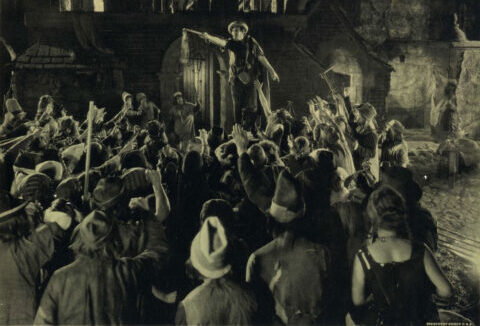
The Phantom of the Opera is still sometimes classed as a “classic” monster, even if he sits slightly outside the pantheon of Universal Monsters, the studio’s great 1926 version having been made before their horror cycle kicked off, and its 1943 remake not trying very hard to be a horror movie. But the even more deformed Quasimodo hardly ever seems to be included, despite the character having been portrayed even more often than Gaston Leroux’s monstrous but tragic creation. There are many similarities between the two characters that extend far beyond they both representing the peak of the career of Lon Chaney, the father of Lon Chaney Jnr, maybe the world’s first horror star [though I guess Conrad Veidt might argue that], even if his creations were rarely actually evil. In any case, I wonder if the fact that Victor Hugo is such a respected writer is one reason why Quasimodo is rarely called a horror icon; another may be that he’s not a major character in the book until near the end, most adaptations cutting down the parts of other characters to make Quasimodo’s part bigger. Also, he’s rarely presented in a scary fashion despite his appearance. RKO’s 1939 version starring Charles Laughton seems to be generally regarded as the best movie version of the story, and I’ve seen it several times, but this earlier telling, which I hadn’t watched before, is no slouch, even if I gather that some of the later versions are closer to the book. This Hunchback Of Notre Dame is a cracking historical drama packed with incident, telling its busy story at a fast pace so that I doubt many modern viewers will be bored even if they aren’t too experienced with silent films. Love, betrayal, lust, torture, mass crowd scenes, comic relief; it really has it all, along with some really strong pathos because of its title character.
It was actually the fifth version of the story. Chaney acquired the rights in 1921, really wanting to play Quasimodo, and planned several productions, one even with a German studio, before producer Irving Thalberg, who’d worked with Chaney several times before, finally took up the challenge and, in order to convince Universal’s founder, Carl Laemmle, to formally approve the production, pitched Hunchback as “a love story”. Thalberg would later claim that he came up with the idea for the film. It was Chaney who called many of the shots, including approving director [Frank Borzage was his first choice] and co-stars, while Patsy Ruth Miller [Esmerelda] said that any direction she received came more from Chaney than from the eventual credited director Wallace Worsley. Chaney’s make-up was his most extreme yet, consisting off a knotted wig, nose putty on the cheeks, some false teeth, a glass eye, a harness that fixed his shoulder to his hip and of course a plaster hump. The harness made him suffer severe pain for the rest of his life, which the fake eye caused tremendous vision loss. Many of the extras for the crowd scenes were recruited in downtown Los Angeles for $1.00 a night and meals. Among them were a good number of prostitutes, who did decent business on the sets. Universal also hired fifty detectives and put them among the crowd, their job being to catch pickpockets and various other thieves among the extras. This film was the first to use intercom technology to act as a communication device between the director and his assistants during production. The most expensive American film yet fortunately became Universal’s biggest hit of the year, but it only survives in 16mm form with thirteen minutes of footage missing, while the failure of the original copyright holder to renew the copyright resulted in it falling into public domain, resulting in lots of awful copies circulating.
Of course the first shot is of Notre Dame itself; well, the side of it which was built for the film, and it’s extremely convincing and accurate. I reckon that many cinemagoers were fooled into thinking that, somehow, the filmmakers were given access to the genuine article. We’re introduced to the Festival of Fools, the one day where the downtrodden poor folk are allowed to have some fun and let loose. This being 1923, we’re allowed to see two men in monkey costumes molesting some women! The repressive King Louis XI doesn’t like seeing this, but he’s not important compared to the large number of other characters that we’re introduced too, most of whom very much want our heroine Esmerelda. There’s Clopin the King of Beggars, shown pushing away either a prostitute or an admirer [it’s hard to tell]. He brought Esmerelda up and now thinks she’s still his property. Then there’s arch-deacon Don Claude, who’s kind to Quasimodo, though the latter spends much of his time as the servant of Claude’s brother Jehan, who isn’t a priest but sometimes naughtily dons the garbs of one. Jehan is not just power hungry but becomes infatuated with Esmerelda. There’s Marie who’s been driven mad by the kidnapping of her child by gypsies and therefore hates all gypsies especially Esmerelda; her introduction is nicely done, shown screaming at Esmerelda but then praying for God to return her child even if only briefly. Gringoire,“a poet of the streets” who fancies Esmerelda. Phoebus who’s just been promoted to Captain of the Guard; he goes to kiss the king’s arm but the latter wants none of it in a film full of amusing little touches despite its essentially tragic nature, albeit a far less tragic nature than Hugo intended. He’s a womaniser who, even though he’s engaged to Fleur de Lys, has Esmerelda as his next target, while she’s besotted with him. Of course there’s Esmerelda herself, an innocent creature of good despite the passion she enflames, plus Quasimodo, whose terribly sad life only has some joy when he rings the bells.
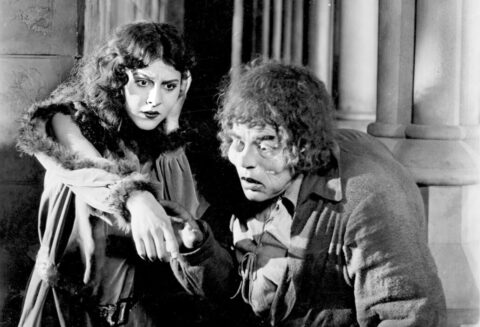
In their desire to include as many strands as possible, screenwriters Edward T. Lowe Jnr and Perley Poole Sheehan end up being vague sometimes, and this also means that Quasimodo doesn’t have much screen time; the 1939 version, knowing that his character was the main draw, increased his role, something that the rather odd – though better than expected – Disney version also did [I haven’t seen any of the other versions except the Anthony Hopkins TV one as a young kid]. Still, most viewers should still be involved. Quasimodo and Esmerelda first meet when she’s dancing and she sees him watching her; after two seconds of revulsion she continues to dance as if nothing had happened, showing her character really well without a single intertitle. Jehan prevails upon Quasimodo to kidnap her, but she’s rescued by Phoebus and a few of his men. Quasimodo is publicly whipped for his troubles but given water by Esmerelda [this moving bit of the story always reminds me of Ben-Hur]. Phoebus sets out to seduce Esmerelda but changes heart and just offers to walk her home instead, in a very nicely played scene – yes, it’s a little melodramatic, but that’s silent movies for you, it’s a very particular art form. He persuades her to accompany him to a ball celebrating his appointment as Captain of the Guard, but Clopin, accompanied by his beggars, crashes the festivities and demands Esmeralda be returned. To avoid bloodshed, Esmeralda says that she does not belong with the aristocracy and leaves Phoebus broken hearted. I’ve always thought this tale to be well known but I’d better not reveal everything that follows just in case – but it really does get bigger and bigger in scale and the already fast pace truly ramps up. Worsley shows off his excellently choreographed crowd scenes with lots of high angle shots, though a huge mass of people remains a huge mass of people with very few closeups, even though Quasimodo’s defense of Notre Dame is still exciting stuff.
Reading the novel around ten years or so ago proved to be a bit of a shocker as – well – I won’t say. There was no way this 1923 film was going to be as downbeat, though the 1939 version did go one better with one particular happening. Phoebus is now promoted to romantic lead while Gringoire, Esmerelda’s husband, is demoted to comic relief. Restrictions of the time forbade the character of Frollo, an evil priest, to be depicted, so here we have a good priest and a nasty guy who sometimes pretends to be a priest, but it’s nice to have another character who treats Quasimodo well. If only the full version had survived though. The King appears in several early scenes but then disappears; other scattered scenes look like they’ve began halfway through or finish halfway through. On the other hand the gipsy who hates Esmerelda is a character who I’d never seen on screen before, even though her arc is rushed at its climax. Again, one feels that the full version may have done her more justice. Some scenes are given quirks which proves that a lot of effort was made to make this film a truly quality production. When Esmerelda and Phoebus sit down at an inn, we cut to a spider in a web moving towards a butterfly; a crude device maybe when seen today but something that would have seemed ambitious at the time as well as ramming home the fact that innocent Esmerelda is about to be seduced then probably abandoned. Just after that, he removes part of her top in a scene that would certainly not have made it into a film eleven years later when the Hays Code got very tough. A bit that I loved was when Quasimodo is about to be whipped; the guy about to do the beating is blown kisses by a lady among the multitude of people watching, and he returns them. What a great way of getting across how people loved [and still love, in a way] seeing such spectacles, how a public flogging was a fun day out for some, how “human nature” is – to be honest – not very nice, yet the scene also did it with humour, which is often the best way to get something like this across.
Chaney is indeed hideous here, especially when we see that his body is full of hair, and Chaney likes to constantly stick his tongue out, in the manner of a lizard. This could have backfired, making him too repulsive especially for 1923 audiences, but it failed to do so. His introductory scene, climbing and sliding down the side of the cathedral, cleverly makes us impressed by the character despite his appearance. We’re always full of sympathy, and Chaney is a good enough actor to convey Quasimodo’s emotions with some subtlety when some rare kindness is given to him. His final scene is both dramatic and touching – yes, Chaney’s milking it for all its worth, but we can easily forgive him, can’t we? The surprisingly naturalistic acting by Miller as Esmerelda makes for a nice balance, even if she doesn’t quite possess the magnetic quality the character ought to have. Ernest Torrence is hugely charismatic as Clopin; we believe that he really can rouse the poor into action. Unfortunately Brandon Hurst’s Phoebus is rather goofy; it’s hard to believe that Esmerelda would fall for him. Still, this Hunchback Of Notre Dame is a thoroughly entertaining effort which, while it loses some of the irony of a tale where the passion that most of the male characters have for one woman leads to their undoing, alternates between big scale incident and intimate melodrama with considerable dexterity, even if it’s clearly been weakened by its shortening.
PRODUCT FEATURES
Limited Edition O-Card Slipcase [2000 units]
1080p presentation on Blu-ray from a 4K restoration conducted by Universal Pictures
Because the only surviving prints are 16mm dupes, this film was never going to look as good as many of the other restorations from the silent days. There are still sections which look quite rough, with a lot of visible print damage. However, I did do a quick comparison with an older version of YouTube, and the improvement is still significant. The poorer portions really do look horrendous in this earlier incarnation, and the rest is certainly much clearer with a lot of detail present that was previously hard to see. So don’t expect miracles, but be assured that this film looks much better than it used to.
Music by Nora Kroll-Rosenbaum & Laura Karpman (presented in uncompressed LPCM stereo)
The score is a really good one, with distinctive themes – Quasimodo’s is suitably brooding and tragic – which blend together well. Especially nice is when carnivalesque music for the poor is mixed into other tracks, most notably Esmerelda’s terrific guitar theme which is probably the one we hear most often.
Brand new audio commentary with author Stephen Jones and author / critic Kim Newman
Previous Blu-rays from North America’s Kino Lorber [which used the same print] and Flicker Alley had different commentaries and some silent newsreel and home movie footage; Eureka offers another commentary and two featurettes. The two don’t disappoint in another superb talk track which is educational and enthusiastic but also objective – for example, neither like Miller’s performance much, but can’t praise Chaney enough. Newman reckons Lowe, who has far more credits than Sheehan, wrote the good parts of the screenplay, while Jones wonders if the lack of violence is because of cuts made for home consumption while enticenly telling us that a Russian print may be complete but it’s unlikely that we’ll ever see it. In fact Jones says more than Newman here, which is unusual but most welcome. Of course other versions are described, and the track ends with us being asked to seek out these other versions. I haven’t seen nearly enough of them, so I may now just do that.
Brand new interview: author / critic Kim Newman on The Hunchback of Notre Dame [22 mins]
Newman repeats a bit of stuff from before, iin particualar going through the other versions, but goes more deeply into the novel which changed the image of hunchbacks for the better, and which was above all else about the evils of society which adaptations tends to downplay. There’s not a huge amount about this particular film, but that’s fine because we get that with the next featurette.
Brand new interview: Jonathan Rigby on The Hunchback of Notre Dame [35 mins]
Rigby goes into a lot of things, from how Quasimodo has always been famous but largely from comedic impersonations – something which leads into the UK showing at the Empire, Leicester Square having a contest to see the best Quasimodo – to Charles Gemora [if you’ve seen a gorilla in an old movie, the chances are it was played by Gemora] having worked on the production, to praising the cast, unlike Newman and Jones who aren’t too keen on some of the performers. I like to see such differences of opinion. A great mix of information about the film and contextual material.
A collector’s booklet featuring a new essay by journalist Philip Kemp, illustrated with archival imagery
Whether this will usurp the 1939 version in my affections is doubtful, but it’s a classic in its own right, and it’s possible that I prefer Chaney’s more animalistic Hunchback. Eureka offer the usual fine supplementary material from three men who I never tire of hearing from. Highly Recommended!




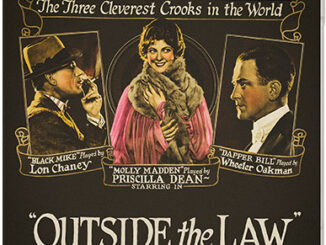
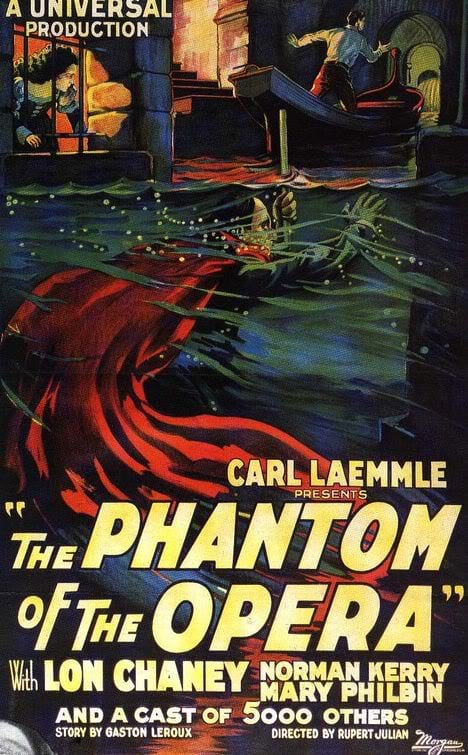
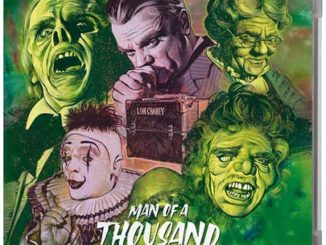
Be the first to comment